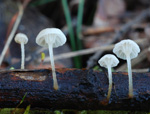Solitary or in small groups on trunks of
deciduous trees, on bark, woody debris and fallen twigs. Occuring from spring to late autumn. Very common and widely distributed in Norway.
Pileus 2-10
mm across, hemispherical, parabolical or convex to plano-convex,
sometimes with a shallow central depression, at other times
also with a small umbo or papilla, flattening with age,
shallowly sulcate, not infrequently somewhat rugulose-gibbous,
more or less markedly translucent-striate, pruinose to minutely
puberulous when young, glabrescent, becoming somewhat lubricous
(dirt sticking to the surface), pale grey-brown or pale
yellowish sepia brown, dark at the centre, paler to dingy
whitish farther outwards, drying whitish. Flesh up to 1
mm thick, pale watery yellowish brownish to dingy whitish. Lamellae
10-17 reaching the stipe, tender, horizontal to arcuate,
up to 2.5 mm broad, broadly adnate and decurrent, smooth,
becoming ribbed and intervenose, white to whitish, or with
some yellowish shade, the edge straight to concave, concolorous.
Stipe 7-30 x 0.5-2 mm, hollow,
fragile, equal or tapering downwards, straight to somewhat
curved, terete, densely but minutely puberulous all over,
watery whitish or yellowish or suffused with a brownish
shade, often more pronouncedly sepia coloured below, the
base more or less densely covered with coarse, whitish fibrils
which fasten it to the substratum. In fresh condition the
apical part of the stipe turns a beautiful wine red to brownish
violet when touched with a small drop of Melzer's reagent. Odour none or slightly farinaceous.
Taste indistinctive.
Basidia 22-28(-35) x
5.5-7 µm, clavate, 2-spored, with
sterigmata 5.5-7 µm long (4-spored basidia
are known to occur). Spores
7.5-10(-11) x 4.5-5.8 µm, Qav 1.8-1.9, pip-shaped to amygdaliform,
smooth, non-amyloid. Cheilocystidia
22-45 x 3.5-8 µm, forming a sterile band, subcylindrical, subfusiform,
clavate, subutriform or somewhat irregularly shaped,
usually simple but also fucate or lobed
or covered with a few excrescences, curved to somewhat
flexuous. Pleurocystidia absent. Lamellar trama
weakly to not dextrinoid. Hyphae
of the pileipellis 1.5-3.5 µm
wide, covered with simple to branched,
more or less cylindrical, curved to flexuous excrescences
1.5-14.5 x 1-3 µm which may form dense masses
and tend to become somewhat gelatinized, with intracellular, brown pigmentation, seen in lower layers of pileipellis.
|
|
Hyphae
of the cortical layer of the stipe
2.5-3.5 µm wide, smooth, covered with caulocystidia
(either solitary or occuring in dense tufts, and sometimes
fairly thick-walled) 15-100 (or more) x 2.5-8 µm.
Clamp connections absent in 2-spored form.
More micro-drawings.
Phloeomana speirea was formerly recognized as a member of Mycena sect. Hiemales.
I have never seen 4-spored basidia in this species.
The form with a yellow stipe is often referred to as f. camptophylla (Berk.) Kühner (e. g. Robich 2006: 379).

Next image
|